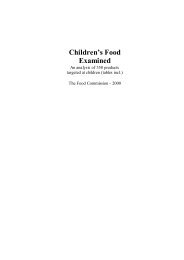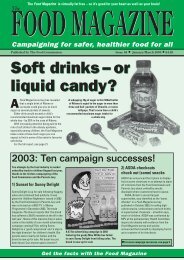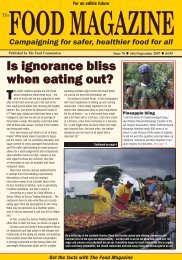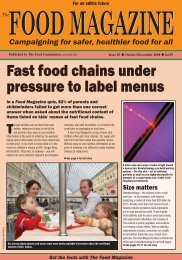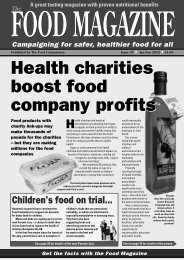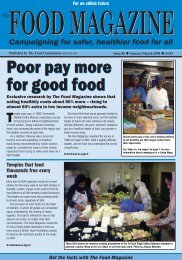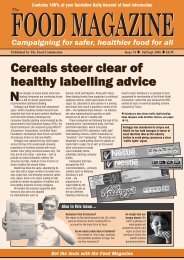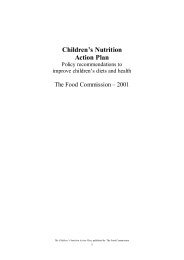Campaigning for safer, healthier food for all - The Food Commission
Campaigning for safer, healthier food for all - The Food Commission
Campaigning for safer, healthier food for all - The Food Commission
You also want an ePaper? Increase the reach of your titles
YUMPU automatically turns print PDFs into web optimized ePapers that Google loves.
news<br />
Two ways to tack<br />
While American lawyers<br />
prepare to take soft<br />
drinks companies to<br />
court over the presence<br />
of benzene in their<br />
products, the measures<br />
taken in the UK tell a<br />
different story.<br />
<strong>The</strong> Boston-based legal firm McRoberts,<br />
Roberts & Rainer is to file class action<br />
law suits against Zone Brands, the makers<br />
of Bellywashers drinks, and a second<br />
manufacturer, Polar Beverages, after<br />
independent laboratory tests found benzene in<br />
several soft drinks on supermarket shelves.<br />
Benzene is a potent carcinogen and<br />
neurotoxin, inducing headaches, dizziness and<br />
sleepiness in sm<strong>all</strong> doses. It is believed to <strong>for</strong>m<br />
in soft drinks that are on shop shelves <strong>for</strong> long<br />
periods, and is generated from acids, such as<br />
ascorbic acid (E300, vitamin C), acting on<br />
benzoate salts, such as the preservative sodium<br />
benzoate (E211).<br />
<strong>The</strong> private legal action comes after the US<br />
government’s <strong>Food</strong> and Drug Administration<br />
<strong>The</strong> trouble with benzene<br />
<strong>The</strong> effects of chronic exposure to low levels<br />
of benzene is not well-documented <strong>for</strong><br />
humans. Epidemiological evidence suggest<br />
that the most sensitive responses to benzene<br />
are those related to the blood-<strong>for</strong>ming organs.<br />
In laboratory animals the exposure levels tend<br />
to be higher <strong>for</strong> shorter periods of time, and<br />
controlled tests suggest there are risks of:<br />
decreased immune responses<br />
bone marrow damage<br />
leukaemia<br />
other cancers<br />
reduced birth weights<br />
damage to foetal DNA<br />
damage to sperm DNA<br />
Source: Prioritization of toxic air contaminants –<br />
en<strong>for</strong>cement of the Children's Environmental Health<br />
Protection Act 2001, Benzene. Office of<br />
Environmental Health Hazard Assessment,<br />
Cali<strong>for</strong>nia, 2004. http://www.oehha.ca.gov/air/<br />
toxic_contaminants/pdf_zip/benzene_final.pdf<br />
(FDA) revealed it had found several soft drinks<br />
products with benzene above the 5 parts per<br />
billion (ppb) limit permitted <strong>for</strong> US drinking water.<br />
Lawyer Tim Howard, a veteran of litigation<br />
against tobacco companies, said: 'Parents have<br />
a legal right to know if benzene is present in<br />
their children's drinks. Responsible corporations<br />
must act to remove these lethal toxins.'<br />
Consumer anger over the finding of benzene<br />
in popular drinks mounted when the FDA<br />
admitted they had first known about the problem<br />
15 years ago, and had agreed with the soft<br />
drinks industry at the time that they would not<br />
make a public announcement provided that the<br />
industry re-<strong>for</strong>mulated their products to reduce<br />
the contamination.<br />
<strong>The</strong> American Beverage Association, whose<br />
chairman is also head of Polar Beverages, stated<br />
that the levels of benzene were safe. <strong>The</strong><br />
association said that people got more benzene<br />
from breathing the air around them every day.<br />
And in the UK?<br />
Matters are rather different in the UK, where our<br />
own <strong>Food</strong> Standards Agency sampled benzene<br />
levels in 150 samples of soft drinks, and found<br />
41 to be contaminated with benzene, including<br />
nine samples that showed benzene levels above<br />
the 5ppb American threshold. We name the<br />
products in the table shown opposite.<br />
However, here in the UK, we do not expect<br />
a class action lawsuit against any of the<br />
companies concerned. And we do not expect<br />
prosecutions from the FSA.<br />
Indeed the FSA released a<br />
statement to the press that<br />
could have been written by<br />
the American Beverage<br />
Association, stating: ‘People<br />
should not be alarmed if they<br />
have drunk these products.<br />
Levels of benzene reported<br />
in this survey will only<br />
make a negligible impact<br />
on people's over<strong>all</strong><br />
exposure to benzene and<br />
so any additional risk to<br />
health is there<strong>for</strong>e likely to<br />
Traces of benzene were<br />
found in several soft<br />
drinks tested in late<br />
2005. Manufacturers<br />
say that they will now<br />
re-<strong>for</strong>mulate although<br />
many have known of<br />
the problem since 1990.<br />
be minimal.’ <strong>The</strong> FSA continued: ‘In more than<br />
two thirds (107 out of 150) of the samples<br />
tested, the levels of benzene were undetectable.<br />
A total of 38 samples had levels of benzene<br />
between 1 and 10 ppb below the guideline level<br />
set by the WHO <strong>for</strong> water of 10 ppb.’<br />
‘People would need to drink more than 20<br />
litres of a drink containing benzene at 10 ppb to<br />
equal the amount of benzene you would breathe<br />
from city air in a day.’<br />
However, when we investigated this casual<br />
reference to benzene from air pollution, we found<br />
that you would have to spend around two<br />
months camped on the pavements of inner<br />
London to absorb the amount you would get<br />
from 20 litres of 10ppb benzene-laced drinks<br />
(see column on the right).<br />
We also ch<strong>all</strong>enge the FSA's casual use of the<br />
World Health Organisation’s definition of<br />
contamination of drinking water, which<br />
recommends levels below 10ppb. This<br />
apparently lenient level is set by the WHO in its<br />
document Guidelines <strong>for</strong> Drinking-Water Quality<br />
3rd edition (current) 2004, which makes it clear<br />
that this level is far from risk-free.<br />
In the footnote to the table specifying the<br />
10ppb limit, the WHO guidelines state that this<br />
value ‘… is the concentration in drinking-water<br />
associated with an upperbound excess lifetime<br />
cancer risk of 10(-5) (one additional cancer per<br />
100,000 of the population ingesting drinking<br />
water containing the substance at the<br />
guideline value <strong>for</strong> 70 years).’<br />
In other words, this level would be<br />
likely to lead to as many as 600 cancer<br />
cases in a population the size of the UK.<br />
But much more alarming is that the<br />
FSA was comparing products to a WHO<br />
guideline rather than to the UK's own<br />
legislation, which has much stricter<br />
requirements <strong>for</strong> drinking water. <strong>The</strong><br />
UK adopted the European<br />
<strong>Food</strong> Magazine 73 18<br />
Apr/Jun 2006



